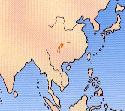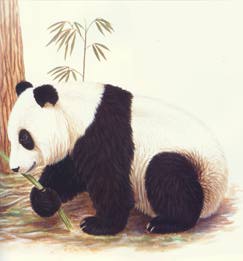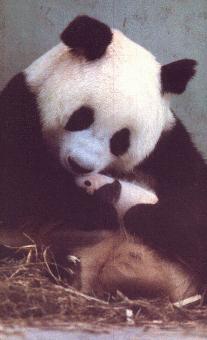|
Panda Bears
The Giant Panda is one of the most recognizable animals in the world, with its stocky build and striking color contrast of black and white patches. The Panda has large black fur patches over its eyes, most of its torso and head are white and its back, legs and ears are black. The coloring acts as camouflage when the Panda moves across the snow.
The People's Republic of China gave the people of the United States a special gift of two giant panda bears in 1972. These pandas, Ling-Ling and Hsing-Hsing (say shing-shing) live in the National Zoo in Washington, D.C. Hsing-Hsing died on November 28, 1999.
Panda Pointers
Although the exact number of giant pandas living in the wild is unknown. Chinese officials estimate the population to be about 1,000.
A full-grown panda weighs about 240 pounds and measures approximately six feet from nose to tail. Ninety-nine percent of the time, giant pandas eat bamboo, but they eat grass, vines, roots, honey, small rodents, and birds as well. A panda eats about 20 pounds of bamboo daily. Pandas have powerful jaws and teeth which crush bamboo. Their esophagi are splinter-proof to resist the jagged edges of bamboo. At birth, pandas only weigh 3 1/2 to 5 1/2 ounces and are only 4 inches in length. This is about the size of a stick of butter. They are born completely white and blind. Many scientists disagree about whether the giant panda is a relative of the bear or raccoon family. At this time, giant pandas are considered to be in a group of their own.
Scientists call the panda Ailuropoda-the animal with the panda kind of foot. The panda's front foot, with its five fingers and thumblike wristbone, is unique in the entire animal kingdom. But this foot is perfect for grasping even the tiniest of bamboo shoots. Pandas are considered to be an endangered species. Several things contribute to this situation. Every 40 or more years, arrow bamboo flowers die out. This occurred in 1983, and as a result, more than 62 giant pandas starved before the bamboo began growing again. Humans also threaten the pandas by hunting them (illegally) and by moving into their territories. Scientists call the panda Ailuropoda-the animal with the panda kind of foot. The panda's front foot, with its five fingers and thumblike wristbone, is unique in the entire animal kingdom. But this foot is perfect for grasping even the tiniest of bamboo shoots.
Activities for ChildrenAn adult panda eats about 20 pounds of bamboo daily. Have your children try canned bamboo shoots and find out if they enjoy them as much as giant pandas do. Have your children determine how many cans of bamboo shoots it would take to feed a panda bear for one day.
Peekaboo in the BambooIn the giant panda's natural habitat, bamboo forests reach ten or twelve feet into the air. Children will enjoy creating their own bamboo thickets in this effective art project. 1. Use a large paintbrush to brush a thick coat of blue tempera paint onto a large sheet of art paper. 2. Place a long piece of plastic wrap vertically on the paper, press, and lift the plastic off the paper without smearing the paint. Repeat this process, working your way across the paper. 3. Paint one side of a wooden stick (3/4" wide or less) green, and press it vertically onto the art paper. Repeat several times for bamboo stalks. 4. Paint the side of your hand green and press it onto the paper repeatedly to make leaves. 5. To make a panda, glue a white party cup, plastic aerosol lid, or beverage mix tub to the back of a seven-inch white paper plate. With black paint or marker, add eye markings, nose, and mouth. Large wiggle eyes are optional. 6. Cut a three-inch, black construction paper circle in half, and glue each piece to the front of the plate for ears. Glue the panda to the bamboo scene. 7. Add a paw near the bottom of the scene by painting your fist black and pressing it onto a bamboo stalk. Repeat. A striking and more time-consuming variation of this project is to make fuzzy panda faces. Wrap a tissue paper square around a pencil eraser, dip in glue, and press onto a paper plate. Repeat until covered with white and black tissue paper. Now that's a panda!
Suggested Children's LiteratureArouse your children's curiousity about the farawy country of China by reading When Panda Came to Our House by Helen Zane Jensen. From the first twinle in Panda's eye, your children will befriend this gentle creature as he imparts enchanted facts about his homeland. And, as Panda bids farewell, he leaves the reader with a bittersweet message about friendships which transcends geographical boundaries. Big Panda, Little Panda by Joan Stimson Dad! I Can't Sleep! by Michael Foreman Giant Pandas: Gifts From China by Allan Fowler Giant Pandas-Untamed World by Karen Dudley Look What Came From China by Miles Harvey The Panda-Wild About Bamboo by Valerie Tracqui Pandas for Kids by Kathy Feeney
Adopted Panda Bear
Panda Links
Georgia's Panda Project-Includes a Panda Cam, info and more! The Bear Den - Giant Panda - Information Everything You Need to Know About the Giant Panda Giant Panda (IBA) - Description Giant Panda Facts - World Wildlife Fund, Endangered Species Panda Cam - Check out the Pandas at San Diego Zoo, also facts and information Panda Clipart and Photos - Panda graphics, photos and more. Pandas Collection - Pictures Panda Mania - Information, links and clipart Pandas, Pandas and more Pandas - Info, news, games, photos World Wildlife Federation's Panda Pages Playing Pandas Short Film (avi)
Background set courtesy of
Animations courtesy of
Many photos and clipart courtesy of Benson Associates
Page created on May 13, 1999
This page is enhanced with the font "Kristen ITC"
|
|---|




 Pandas are basically solitary creatures, although males and females living in the same area are likely to be familiar with each other and even interact once in awhile. Pandas are surprisingly vocal animals and in the wild, eleven distinct calls have been identified, though their meanings are unknown. Even though it turns cold in the forest, Pandas do not hibernate. They just move to lower elevations during the winter to stay warm and then move to higher elevations in the summer to stay cooler. Pandas do not have permanent homes either, like caves, but they will sleep at the bottom of a tree, under an old stump or any other sheltered place they find. They are active mostly at twilight and during the night.
Pandas are basically solitary creatures, although males and females living in the same area are likely to be familiar with each other and even interact once in awhile. Pandas are surprisingly vocal animals and in the wild, eleven distinct calls have been identified, though their meanings are unknown. Even though it turns cold in the forest, Pandas do not hibernate. They just move to lower elevations during the winter to stay warm and then move to higher elevations in the summer to stay cooler. Pandas do not have permanent homes either, like caves, but they will sleep at the bottom of a tree, under an old stump or any other sheltered place they find. They are active mostly at twilight and during the night.
 The lovable and adorable Panda is one of the most
popular animals in the world. It is also one of the most endangered. The Giant Pandas are the recognized international symbol of endangered species. The
The lovable and adorable Panda is one of the most
popular animals in the world. It is also one of the most endangered. The Giant Pandas are the recognized international symbol of endangered species. The  In North America, only the
In North America, only the 


 Giant pandas live only on the rim of the mountains in central China's Sichuan basin.
Giant pandas live only on the rim of the mountains in central China's Sichuan basin.











